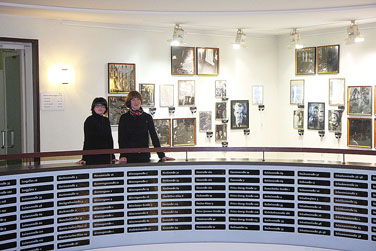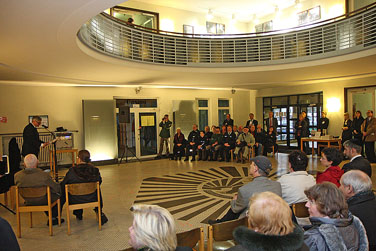Exhibition opening: Between obedience and conscience – pogrom of November 1938
(mk) Ceremonies and celebrations were held throughout Germany on 9th November 2009 to mark the 20th anniversary of the fall of the Berlin Wall and the peaceful revolution in the GDR. Apart from this happy event, it was also the anniversary of another, much darker episode in German history: 71 years ago, in the night of the 9th and on the following 10th November 1938, Jewish citizens were humiliated, attacked and murdered, their homes and businesses were ransacked and synagogues were set on fire all over Germany in what the Nazis called the "Kristallnacht", or "night of the broken glass". The November pogrom represented the next deliberate step in the discrimination of German Jews after the Nazis had seized power in Germany in 1933, ending in the systematic persecution and murder of European Jews in their sphere of power and influence.
The "History in Jürgensplatz" Society has now put together an exhibition on behalf of Düsseldorf's police force which also deals with the role of the police during the Third Reich and the persecution of the Jews. The exhibition entitled "Between obedience and conscience – the November pogrom of 1938" was designed and implemented by Simone Kapeller and Anette Hentrich under the supervision of Prof. Uwe J. Reinhardt and Prof. Philipp Teufel. In designing the exhibition, the two students on the Master course Exhibition Design deployed diverse media which relate to actual events, but which also leave metaphorical space open for reflection. For instance, they installed black street signs in the first storey of the foyer's rotunda in the main building of the police headquarters. These list the 463 known addresses in Düsseldorf at which Jews were mistreated and their property destroyed, "whereby the real number is probably much higher", emphasises Dr. Bastian Fleermann, deputy head of the Remembrance Memorial in Düsseldorf: "In some places, criminal acts were not followed up and not even recorded. Particularly against this background, our Society's present-day collaboration with the police can be regarded as exemplary because they face up to their past openly and without compromise." In his opening speech, Police Commissioner Herbert Schenkelberg also referred to the close institutional ties and personnel linkages of the police at that time in the happenings of the pogrom night, and emphasised the importance of not forgetting the mechanisms which led up to these and allowed them to happen. "Especially as many younger people have difficultly associating with what happened because they did not actually witness the events, we need such important days of remembrance as well as the appropriate memorials."
As another main feature of the exhibition besides the street signs, the students positioned so-called "standpoints" in the foyer of the police headquarters as panes of opaque glass with historical background information, underlaid with old photographs or posters. Further historic photos were mounted in the upper storey. These were slightly defamiliarised by the designers, in that they enlarged them and printed them on silver paper. "The shiny effect that this creates provides an additional, symbolical level for reflection, likewise the splintered glass in the picture frames which primarily represent the broken objects, although they can also be interpreted as a metaphor for inner strife", is how Anette Hentrich explains the symbolism of the individual levels of the exhibition. Boxes with MP 3 players were additionally attached to some of the photos, on which witnesses of those days have their say, such as Günther Katzenstein, for instance. 18-years old at the time, he had to lay slabs around the entrance to the police headquarters as a forced labourer and had travelled from his home in Sweden solely for the remembrance day of the night of the pogrom.
The exhibition can still be seen until 30th November Mondays to Fridays from 7.30 - 15.30 hours in the foyer of the police headquarters, Jürgensplatz 5-7, 40219 Düsseldorf.

